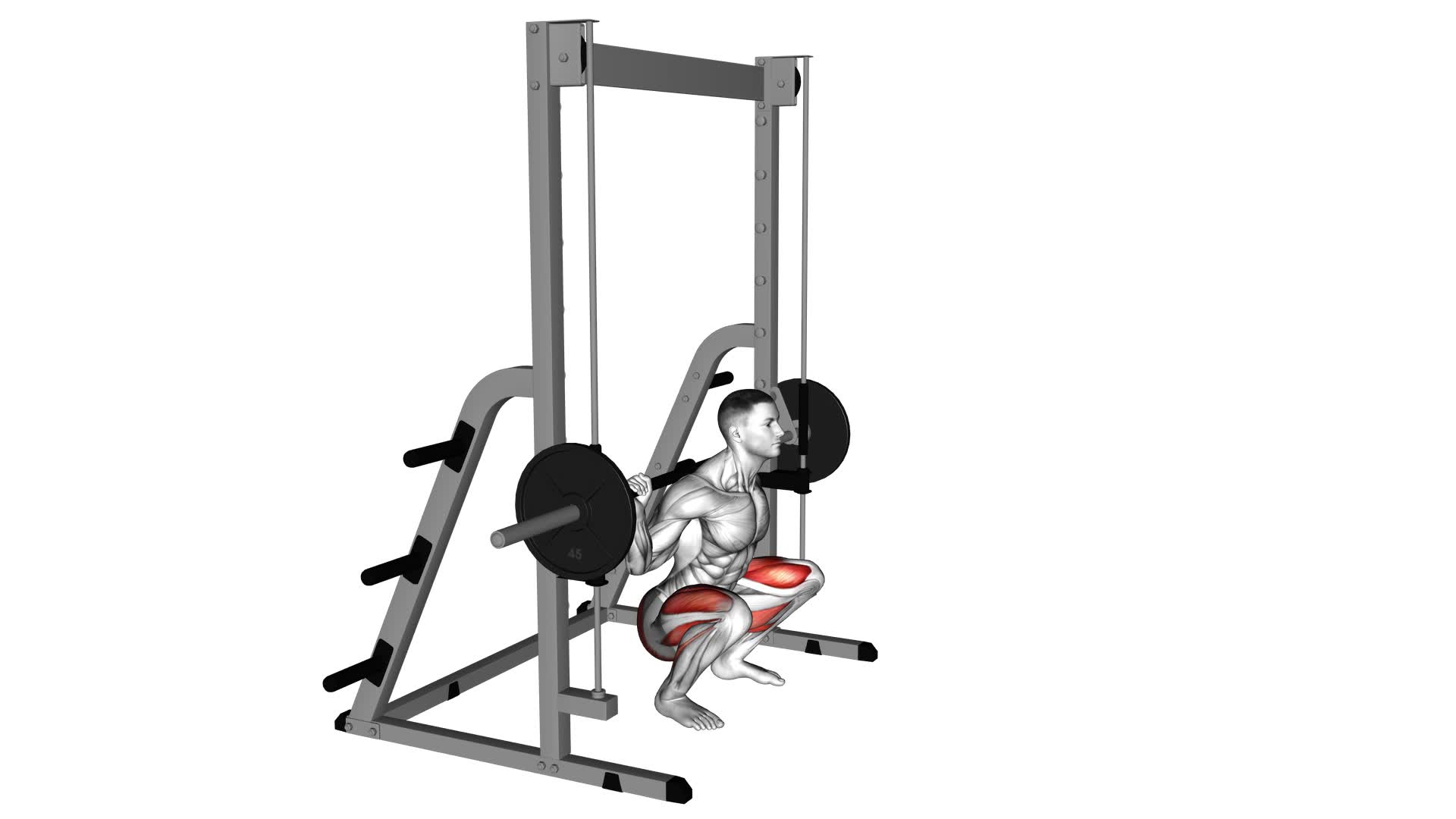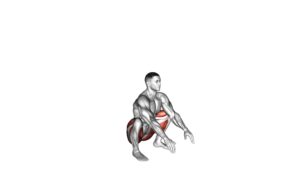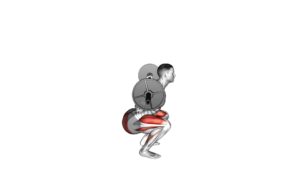Smith Full Squat – Video Exercise Guide & Tips

Are you looking to improve your lower body strength and build muscle? The Smith Full Squat is a fantastic exercise that targets your quadriceps, hamstrings, and glutes.
Watch This Exercise Video
In this article, we will guide you through the proper form and technique for performing this exercise, as well as provide helpful tips and variations to keep your workouts challenging and effective.
Get ready to take your squat game to the next level with our Smith Full Squat video exercise guide and tips. Let's get started!
Key Takeaways
- The Smith Full Squat targets the quadriceps, hamstrings, and glutes, helping to build lower body strength and power.
- This exercise improves balance and stability, which can enhance athletic performance in activities such as running, jumping, and lifting.
- The Smith Full Squat promotes muscle activation and definition, making it a great exercise for those looking to sculpt their lower body.
- Proper form and technique, including maintaining hip and knee alignment and using the Smith machine for stability, are crucial for maximizing the benefits of the Smith Full Squat.
Benefits of the Smith Full Squat
One of the main benefits of the Smith Full Squat is its ability to strengthen your quadriceps and glutes. This exercise specifically targets these muscles, providing an effective way to build strength and improve overall lower body power. By performing the Smith Full Squat, you activate the muscles in your quadriceps, which are located in the front of your thighs, and your glutes, which are the muscles in your buttocks. The controlled movement of the squat helps to engage these muscles and promote muscle activation.
In addition to strengthening your quadriceps and glutes, the Smith Full Squat also offers other benefits. It helps to improve your balance and stability, as the exercise requires you to maintain proper form throughout the movement. This can be particularly beneficial for athletes who need to have a strong base and stability in their lower body.
Furthermore, the Smith Full Squat can also help to increase your overall lower body strength and enhance your athletic performance in activities such as running, jumping, and lifting. Incorporating this exercise into your fitness routine can provide numerous benefits and contribute to a stronger and more powerful lower body.
Equipment Needed for the Smith Full Squat
To perform the Smith Full Squat, you'll need a Smith machine. The Smith machine is a piece of equipment that consists of a barbell fixed within steel rails, allowing for vertical movement while providing stability. It's essential for performing the Smith Full Squat as it ensures proper form and reduces the risk of injury.
In addition to the Smith machine, you may also need a weight rack to store the plates used for resistance. It's important to choose the appropriate weight for your fitness level and goals.
When performing the Smith Full Squat, you have the option to use variations such as the narrow stance or wide stance. These variations target different muscle groups and can help you achieve specific fitness goals.
The Smith Full Squat offers several benefits, including increased lower body strength, improved balance and stability, and enhanced muscle definition in the quadriceps, hamstrings, and glutes. It also engages the core muscles, promoting overall strength and stability.
Remember to consult with a fitness professional or trainer to ensure proper form and technique when performing the Smith Full Squat. They can guide you in selecting the right equipment and provide valuable tips to maximize your workout.
Proper Form and Technique for the Smith Full Squat
To perform the Smith Full Squat with proper form and technique, it's crucial to focus on hip and knee alignment. Make sure that your knees are in line with your toes and your hips are pushed back as you lower down.
Additionally, pay attention to the positioning of the barbell on your shoulders, ensuring it's securely resting without putting excessive strain on your neck or upper back.
Hip and Knee Alignment
Maintaining proper hip and knee alignment is crucial for performing the Smith Full Squat with proper form and technique. Here are three key points to keep in mind:
- Hip mobility: Ensuring adequate hip mobility is essential for a successful Smith Full Squat. Proper hip mobility allows for a full range of motion, enabling you to lower yourself into the squat position without any restrictions. To improve hip mobility, incorporate exercises such as hip openers and stretches into your routine.
- Knee stability: Strong and stable knees are vital to prevent injuries during the Smith Full Squat. Keep your knees in line with your toes throughout the movement, avoiding any inward collapse or excessive outward rotation. Strengthening the muscles around the knees, such as the quadriceps and hamstrings, can help improve knee stability.
- Proper form and technique: Focus on maintaining a neutral spine, engaging your core, and keeping your chest lifted throughout the squat. Additionally, ensure that your feet are shoulder-width apart, with the toes pointing slightly outward. Remember to lower yourself down until your thighs are parallel to the ground, then push through your heels to return to the starting position.
Barbell Positioning
Ensure proper barbell positioning is key to executing the Smith Full Squat with optimal form and technique. When using a Smith machine, the advantages are that it provides a guided range of motion and stability, reducing the risk of injury.
To properly position the barbell, place it on the hooks of the Smith machine at shoulder height. Step underneath the bar and position it across your upper back, just below the base of your neck. Keep your hands slightly wider than shoulder-width apart, gripping the bar firmly. This positioning allows for proper stability and control throughout the exercise.
By targeting different muscle groups, such as the quadriceps, hamstrings, and glutes, the Smith Full Squat is an effective exercise for overall lower body strength and development.
Remember to maintain proper form and technique to maximize your results.
Common Mistakes to Avoid When Performing the Smith Full Squat
You can avoid common mistakes when performing the Smith Full Squat by focusing on proper form and technique. Here are three important points to keep in mind:
- Maintaining proper alignment: One of the most common mistakes is allowing your knees to cave inward as you descend into the squat. This puts unnecessary stress on the knee joints and can lead to injury. Instead, focus on keeping your knees in line with your toes throughout the entire movement. Engage your glutes and core to help with stability and alignment.
- Going too low: While it's important to achieve a full range of motion, going too low in the Smith Full Squat can cause excessive stress on the knees and lower back. Aim to squat until your thighs are parallel to the ground or slightly below. This will ensure that you're engaging your muscles effectively without compromising your form.
- Rushing the movement: Another common mistake is rushing through the squat without proper control. Take your time to lower yourself down and then push through your heels to rise back up. This will allow for better activation of the muscles and reduce the risk of injury.
By avoiding these common mistakes and focusing on proper form, you can maximize the benefits of the Smith Full Squat and minimize the risk of injury.
Now, let's explore some variations and modifications for this exercise.
Variations and Modifications for the Smith Full Squat
To add variety and challenge to your workout, try incorporating different variations and modifications of the Smith Full Squat.
By making small changes to the exercise, you can target different muscle groups and keep your routine interesting.
One variation you can try is the Smith Close Stance Squat. Instead of placing your feet shoulder-width apart, bring them closer together so that they're almost touching. This will engage your inner thighs and glutes to a greater extent.
Another variation is the Smith Sumo Squat. Instead of facing forward, turn your toes outwards at a 45-degree angle. This will target your inner thighs and hamstrings more intensely.
If you're looking for a modification that reduces the intensity of the Smith Full Squat, you can try the Smith Half Squat. Instead of lowering yourself all the way down, only go halfway and then come back up. This modification can be useful if you have knee or hip issues.
Remember to always maintain proper form and consult with a fitness professional before attempting any new variations or modifications.
Tips for Incorporating the Smith Full Squat Into Your Workout Routine
Incorporate the Smith Full Squat into your workout routine for an effective lower body exercise. Here are some tips to help you maximize your results:
- Start with proper form: Before adding weight to the bar, make sure you have mastered the basic squat technique. Keep your feet shoulder-width apart, chest up, and lower yourself down until your thighs are parallel to the ground. Maintain a neutral spine throughout the movement.
- Gradually increase weight: As you become more comfortable with the Smith Full Squat, gradually increase the amount of weight you're lifting. This will challenge your muscles and help you build strength and size in your lower body.
- Incorporate modifications: To add variation to your routine, consider incorporating modifications such as paused squats or wide stance squats. These variations target different muscles and can help prevent plateaus in your progress.
By incorporating modifications and ensuring proper form, you can reap the benefits of the Smith Full Squat. This exercise targets your quadriceps, hamstrings, and glutes, helping you build strength, improve balance, and increase lower body power.
Remember to listen to your body and adjust the weight and intensity as needed. Happy squatting!
Frequently Asked Questions
How Many Sets and Reps Should I Do When Performing the Smith Full Squat?
When performing the Smith full squat, it's important to consider your goals and fitness level. To determine the number of sets and reps, you can use your one rep max calculation as a guide. This will help you gauge the appropriate weight and intensity for your workout.
Additionally, there are variations of the Smith full squat that you can incorporate into your routine to target different muscle groups. Remember to consult with a fitness professional for personalized guidance.
Can the Smith Full Squat Help With Increasing Vertical Jump Height?
The Smith full squat is a great exercise for increasing vertical jump height. By incorporating this exercise into your strength training program, you can improve your leg strength and power, which are essential for jumping higher.
To perform the Smith full squat effectively, make sure to position your feet shoulder-width apart, lower your body until your thighs are parallel to the ground, and push through your heels to return to the starting position.
Consistency and proper form are key to maximizing the benefits of this exercise.
Are There Any Alternative Exercises That Can Target Similar Muscle Groups as the Smith Full Squat?
If you're looking for alternative exercises that target similar muscle groups as the smith full squat, there are a few options you can try.
Lunges are a great exercise that work your quads, hamstrings, and glutes.
Bulgarian split squats also target these muscle groups and can be done with or without weights.
Additionally, step-ups and box jumps can help strengthen your legs and improve power.
Incorporating these exercises into your routine can provide variety and help you achieve your fitness goals.
Is It Safe to Perform the Smith Full Squat Without a Spotter?
Performing the Smith Full Squat without a spotter can be risky. Safety precautions should always be a priority when exercising. Having a spotter provides added support and ensures proper form, reducing the risk of injury. They can assist you in case you struggle with the weight or lose balance.
Additionally, a spotter can motivate and push you to reach your limits, enhancing your overall workout experience.
How Long Should I Rest Between Sets When Incorporating the Smith Full Squat Into My Workout Routine?
When incorporating the Smith Full Squat into your workout routine, it's important to consider rest intervals for optimal results. Resting between sets allows your muscles to recover and prepare for the next set.
The duration of rest intervals may vary depending on your fitness level and goals. It's generally recommended to rest for 1-3 minutes between sets to ensure proper form and prevent fatigue.
Remember to listen to your body and adjust the rest intervals accordingly.
Conclusion
In conclusion, the Smith Full Squat is a beneficial exercise that can be incorporated into your workout routine.
It targets multiple muscle groups and helps improve lower body strength and stability.
By using proper form and technique, and avoiding common mistakes, you can maximize the benefits of this exercise.
Remember to start with lighter weights and gradually increase the load as you become more comfortable and confident.
With consistency and proper execution, the Smith Full Squat can be a valuable addition to your fitness routine.

Author
Years ago, the spark of my life’s passion ignited in my mind the moment I stepped into the local gym for the first time. The inaugural bead of perspiration, the initial endeavor, the very first surge of endorphins, and a sense of pride that washed over me post-workout marked the beginning of my deep-seated interest in strength sports, fitness, and sports nutrition. This very curiosity blossomed rapidly into a profound fascination, propelling me to earn a Master’s degree in Physical Education from the Academy of Physical Education in Krakow, followed by a Sports Manager diploma from the Jagiellonian University. My journey of growth led me to gain more specialized qualifications, such as being a certified personal trainer with a focus on sports dietetics, a lifeguard, and an instructor for wellness and corrective gymnastics. Theoretical knowledge paired seamlessly with practical experience, reinforcing my belief that the transformation of individuals under my guidance was also a reflection of my personal growth. This belief holds true even today. Each day, I strive to push the boundaries and explore new realms. These realms gently elevate me to greater heights. The unique combination of passion for my field and the continuous quest for growth fuels my drive to break new ground.







